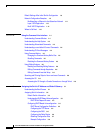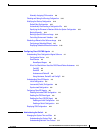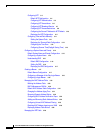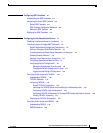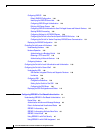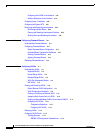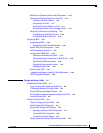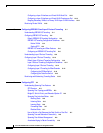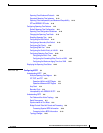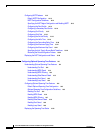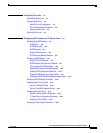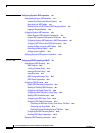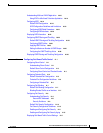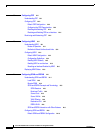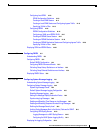
Contents
xii
Cisco ME 3400 Ethernet Access Switch Software Configuration Guide
78-17058-01
Configuring a Layer 2 Interface as a Private-VLAN Host Port 12-12
Configuring a Layer 2 Interface as a Private-VLAN Promiscuous Port 12-13
Mapping Secondary VLANs to a Primary VLAN Layer 3 VLAN Interface 12-14
Monitoring Private VLANs 12-15
CHAPTER
13 Configuring IEEE 802.1Q and Layer 2 Protocol Tunneling 13-1
Understanding IEEE 802.1Q Tunneling 13-1
Configuring IEEE 802.1Q Tunneling 13-4
Default IEEE 802.1Q Tunneling Configuration 13-4
IEEE 802.1Q Tunneling Configuration Guidelines 13-4
Native VLANs 13-4
System MTU 13-5
IEEE 802.1Q Tunneling and Other Features 13-6
Configuring an IEEE 802.1Q Tunneling Port 13-6
Understanding Layer 2 Protocol Tunneling 13-8
Configuring Layer 2 Protocol Tunneling 13-10
Default Layer 2 Protocol Tunneling Configuration 13-11
Layer 2 Protocol Tunneling Configuration Guidelines 13-11
Configuring Layer 2 Protocol Tunneling 13-12
Configuring Layer 2 Tunneling for EtherChannels 13-14
Configuring the SP Edge Switch 13-14
Configuring the Customer Switch 13-15
Monitoring and Maintaining Tunneling Status 13-18
CHAPTER
14 Configuring STP 14-1
Understanding Spanning-Tree Features 14-1
STP Overview 14-2
Spanning-Tree Topology and BPDUs 14-3
Bridge ID, Switch Priority, and Extended System ID 14-4
Spanning-Tree Interface States 14-4
Blocking State 14-6
Listening State 14-6
Learning State 14-6
Forwarding State 14-7
Disabled State 14-7
How a Switch or Port Becomes the Root Switch or Root Port 14-7
Spanning Tree and Redundant Connectivity 14-8
Spanning-Tree Address Management 14-8
Accelerated Aging to Retain Connectivity 14-9



